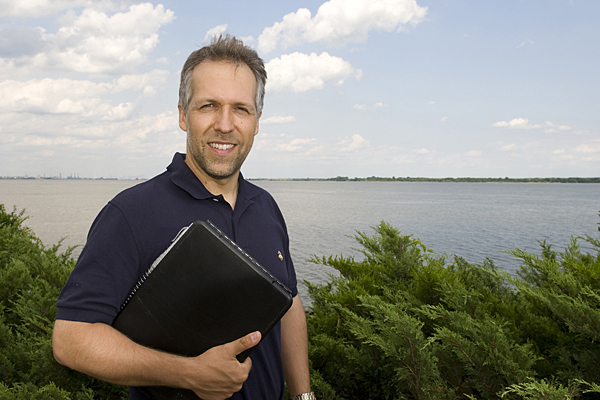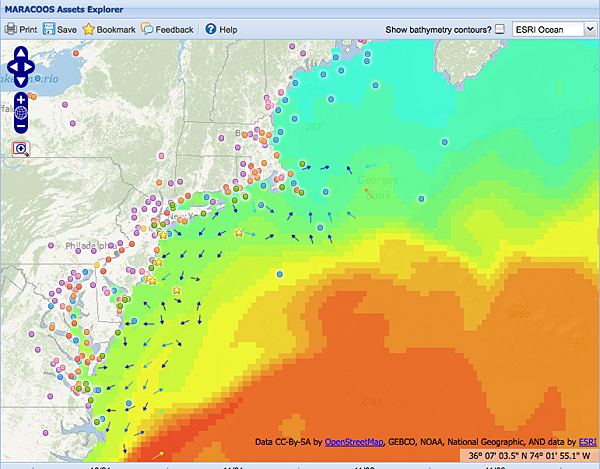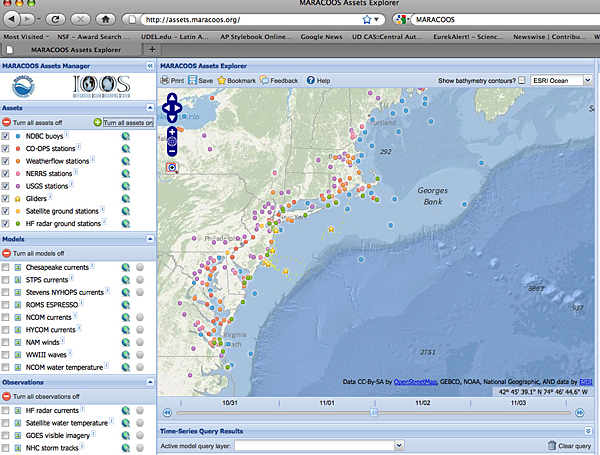


Ocean of opportunity
UD-led network takes ocean's pulse for public benefit
3:53 p.m., Nov. 1, 2011--A University of Delaware-led network in the Mid-Atlantic has its finger on the ocean’s “pulse” and is putting that data to use -- to save lives, improve flood warnings, protect fish stocks from overfishing while enhancing the fishing experience, save shipping time and fuel costs, and even spawn new businesses.
These are just a few of the applications, both real and potential, for the extensive data being gathered by the Mid-Atlantic Regional Association Coastal Ocean Observing System (MARACOOS), according to its new executive director, Gerhard Kuska.
Research Stories
Chronic wounds
Prof. Heck's legacy
Kuska, who holds both a bachelor’s degree in political science and a doctorate in marine policy from UD, is providing day-to-day management of MARACOOS working with Carolyn Thoroughgood, professor of marine biosciences in UD’s College of Earth, Ocean, and Environment (CEOE).
Thoroughgood is the co-principal investigator on a $2.1 million research grant from the National Oceanic and Atmospheric Administration (NOAA), which supports the management and operation of the multi-institutional observing system during the next phase of its growth. NOAA’s investment has been leveraged seven-fold with funding coming from other federal agencies and the private sector, according to Thoroughgood, who also chairs the MARACOOS board of directors.
“Since the Mid-Atlantic system was created seven years ago, dozens of monitoring instruments have come online thanks to the efforts of dedicated partners, and MARACOOS has made significant progress in translating the resulting ocean data into real benefits for the public,” says Thoroughgood. “We’re proud that MARACOOS has been referred to as a ‘model for the world to follow’ in providing ocean data in an effective and efficient way.”
Spanning the coast from Cape Cod, Mass., to Cape Hatteras, N.C., MARACOOS, a non-profit corporation, has more than 40 member institutions, including universities, federal and state agencies, and private companies. It is one of 11 regional observing systems that form the U.S. Integrated Ocean Observing System, which, in turn, is part of a growing global ocean observing network.
MARACOOS has launched dozens of real-time data gatherers above and below the sea surface, from weather buoys and robotic underwater gliders, to satellites and high-frequency (HF) radar stations. (A map is available on the MARACOOS website.) More than 30 HF radar sensors measure the speed and direction of ocean surface currents — data critical to the U.S. Coast Guard’s search-and-rescue response.
“MARACOOS provides the Coast Guard in the Mid-Atlantic region with data to expedite search-and-rescue missions and save lives,” Kuska notes. “The network’s data also is providing the capability to predict flooding to the street level during major storms, and it is being used to identify the best wind resources for proposed offshore wind structures.”
When millions of gallons of raw sewage spilled into the Hudson and Harlem rivers due to a major fire at a sewage treatment plant this past July, MARACOOS partners used their data modeling capabilities to identify which beaches and shellfishing areas downstream would be at risk of contamination and should be restricted to the public.
Even when U.S. Airways Flight 1549 came down in the Hudson River on Jan. 15, 2009, disabled when it struck a flock of Canada geese, MARACOOS provided information on the trajectory of the downed plane based on prevailing wind and water currents, and advised responders where to tow the plane to safely unload passengers, Kuska says.
A key priority in the next phase of MARACOOS’ development is to fine tune its data products to make them as practical and user-friendly as possible, according to Kuska. “We are looking forward to not only enhancing our existing products, but also developing new applications across a variety of users,” Kuska notes. A “stakeholder liaison” will be hired soon to assist with that effort.
Kuska also sees private companies taking the observing system’s data and developing new products for sale.
“As MARACOOS moves from observing to forecasting, these data and models will go from supporting the economy to becoming an economic driver,” Kuska says. “Others can generate income by adding value to our products. It’s similar to the Weather Service, and people developing user-friendly products from their data — that’s the next step in MARACOOS’ evolution.”
Among his many accomplishments, Kuska has crafted ocean policy for the United Nations, worked on the staff of the U.S. Commission on Ocean Policy and NOAA, served as director of ocean and coastal policy under President George W. Bush, and previously spent a decade in the maritime transportation management sector — an important user community for MARACOOS.
“It’s nice to be back in Delaware, and working for the University,” says Kuska, who also serves on the Dean’s Advisory Council for CEOE and as a senior fellow with the Gerard J. Mangone Center for Marine Policy. “I’m excited to be part of this regional effort that is promoting important science and contributing to the economic, environmental, and general well-being of the 76 million people in the Mid-Atlantic region.”
The headquarters for MARACOOS is moving from the Delaware Biotechnology Institute to 318 S. College Ave. The new office is expected to be up and running by the end of November.
Article by Tracey Bryant










